Martin & Mandy
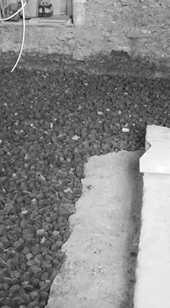
We know where the Yorkstone floor is coming from now we just need something to put it on, and I don't fancy any more concrete this week. Mainly because it does not really breath and allow movement, and the whole building breaths and moves - so a limecrete floor is what we need.
Enter Myles stage left with a selection of wild pieces of equipment. Peter and his chaps have already got all the plumbing and pipework laid in the nave and incredibly there's 250 meters of it. The steel frame for the kitchen is all in place and we basically have a hole across all of the Nave.
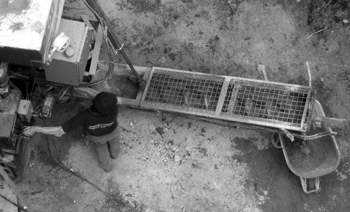
The first thing we need to put down is a 180mm layer of insulation, this looks like volcanic rock, it's pieces the size of golf balls which are very light. It's also a rather good insulator so that's a great start. This all gets tamped down really delicately until it's level and lightly compressed so it will then provide a firm base for the limecrete. Then there is a white plastic expansion material that's put around the outside of the space the slab is going to be laid in, and also around the services that come up through the slab. Finally it's eco-friendly because it's reclaimed - trouble is everybody forgets to tell you how much electricity is used to produce it which makes it not very green at all. Hey ho - we tried! Then you get a large 6by6 off road truck and chop the back axle off it to make it short and stubby so it's able to get anywhere, buy an American grout mixing plant for spraying concrete onto walls and mount that on the back of it, then fill the hopper on top with a lime based aggregate and a vast quantity of lime, pour water in and let the wild mixing thing on the back of it carefully mix vast amounts of limecrete and have three blokes on standby with barrows to lay it in the Nave - easy really if you say it quick. It's all a little bit like mixing concrete but the proportions and the timing is vastly more inportant. 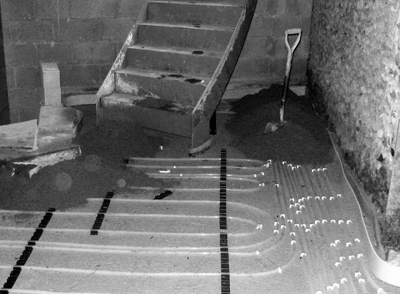 For example I've never really been interested in the exact temperature but my phone now has a weather app on it to tell me the temperature in Buntingford for the next 10 days - all this has to happen when there's no frost around so the limecrete can set without freezing which would make it crack and we would need to start again. So now we have a 150mm thick layer of limecrete on top of the eco-friendly (not) glass foundation - now you leave it alone for a week to set before the next stage, which is under floor heating (UFH) pipes. There is a manifold hidden under the small stub staircase - this basically has seven loops of pipe attached to it and the heating system pumps hot water from the main boiler room around the system, the pipework is laid out across the floor and winds backwards and forwards across the areas that we will walk on - no point putting it under the kitchen units for example.
For example I've never really been interested in the exact temperature but my phone now has a weather app on it to tell me the temperature in Buntingford for the next 10 days - all this has to happen when there's no frost around so the limecrete can set without freezing which would make it crack and we would need to start again. So now we have a 150mm thick layer of limecrete on top of the eco-friendly (not) glass foundation - now you leave it alone for a week to set before the next stage, which is under floor heating (UFH) pipes. There is a manifold hidden under the small stub staircase - this basically has seven loops of pipe attached to it and the heating system pumps hot water from the main boiler room around the system, the pipework is laid out across the floor and winds backwards and forwards across the areas that we will walk on - no point putting it under the kitchen units for example. 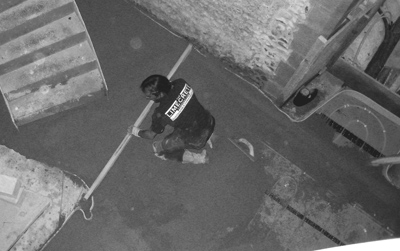 Once the UFH pipe is in we can then lay the next 70mm screen to cover it all up. Again this is a limecrete mix but a different mix ratio to the main slab. The mad machine, plus Myles and his mates turn up again, and in another day the screed is finished and we need to leave the floor for yet another week to dry out. It's no wonder this kind of process is not really used on large builds with all the waiting that's involved.
Once the UFH pipe is in we can then lay the next 70mm screen to cover it all up. Again this is a limecrete mix but a different mix ratio to the main slab. The mad machine, plus Myles and his mates turn up again, and in another day the screed is finished and we need to leave the floor for yet another week to dry out. It's no wonder this kind of process is not really used on large builds with all the waiting that's involved.
It's also an interesting game getting the different layers to bond with one another - you have to leave the limcrete slab to dry out but then the first thing you do before laying the screed is to pour loads of water onto it so that it does not suck all the water out of the screed as it's laid. Once it's all properly dried, which I suspect will be a month or so's time, we can get the Yorkstone shipped down from Comedy Dave's mate Spider Steve. We will then add a 20mm layer of lime morter on top of the screed and then 50mm stone slabs on top of that. A spot of pointing and we will have a finished floor.
For more history and information related to St Bartholomew's visit www.layston-church.org.uk or follow us on Twitter @layston_herts
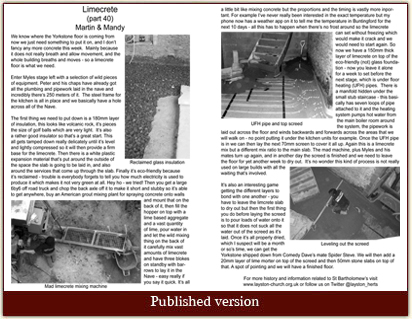
 |
|
 |

